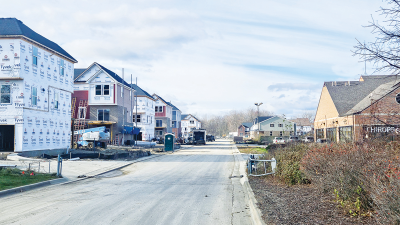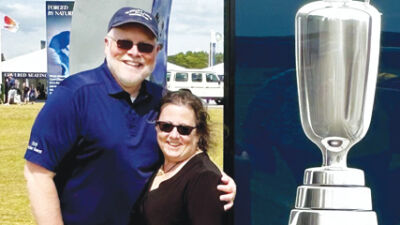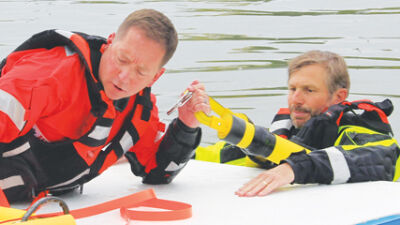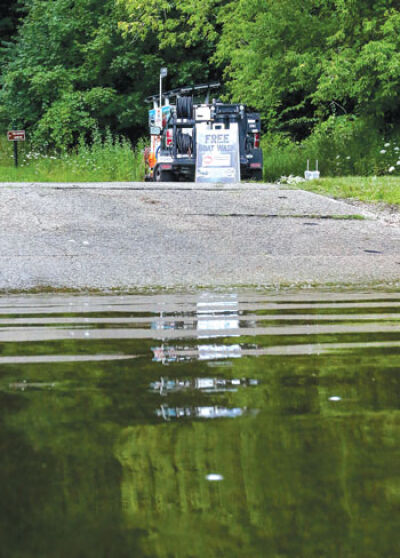
The Clinton River Watershed Council partnered with the Oakland County Parks and Recreation Department and the MSU Extension to host boat washes at the Orchard Lake launch July 28. The goal of the boat washes is to help raise awareness about the importance of preventing aquatic invasive species, which can spread via watercraft.
Photo by Patricia O’Blenes
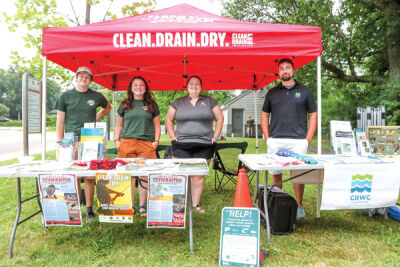
From the left, Ian Keller, Tyler Lidgard, Kelsey Bockelman and Eric Diesing participate in an event to help raise awareness about the spread of aquatic invasive species in local waterways.
Photo by Patricia O’Blenes
METRO DETROIT — Clinton River Watershed Council Chief Watershed Ecologist Eric Diesing recently said that the presence of aquatic invasive species on Michigan waterways has been a problem for “quite a while.”
Aquatic invasive species include non-native plants, animals and other organisms, and according to a press release, it is an issue that “can harm our local economy, environment and even our health.”
The Clinton River Watershed Council partnered with the Oakland County Parks and Recreation Department and the MSU Extension to host a boat wash at the Orchard Lake Boat Launch July 28.
The event offered free boat washes to help raise awareness about the importance of preventing aquatic invasive species.
Diesing was on hand for the event.
“The goal of boat cleaning is to prevent the spread of invasive species from lake to lake. A lot of recreationists, whether they be general boaters, anglers, paddlers — (if) they put their equipment in a lake, and if that lake has invasive species, the plants, the animals and such can get attached to that equipment, and then they move that equipment to a new lake, and the new lake can become infested, if it isn’t already infested,” Diesing said. “So the idea behind cleaning your equipment after you leave the lake is that you leave everything that was in that lake at that lake; you’re not contributing to the spread to a new water body.”
Diesing explained what aquatic invasive species are.
“Invasive species, by definition, is any species that is not native to the area, that causes harm to the economy, public health or the environment,” he said.
One example of an invasive species that Diesing cited is European frog-bit, which he said is a “tiny,” floating lily pad that is not native to Michigan.
“Where that’s been introduced, we see reduction in our native plants at the bottom of the lake because it’ll shade-out the sunlight from getting down to them,” Diesing said. “It’ll also cause major issues for boaters because it can clog engines (and) propellers; it creates super thick, dense mass across the top of the water.”
Sarah Cook-Maylen is the chief of environmental sustainability and planning for Oakland County Parks. She shared her concerns about the issue of aquatic invasive species in local waterways.
“People accidentally transport new species that aren’t found in lakes that are currently in Oakland County or in waterways, so things that we didn’t have here before were picked up somewhere else and brought back to Oakland County,” she said. “That’s what we’re most concerned about — new species that are coming in. Then, of course, we also don’t (want to) transport species that are already here between lakes. People can do that through their recreational vehicles — so through boats, through kayaks, things like that.”
Cook-Maylen also said that invasive species can be transported via fishing and “hobby” equipment.
Diesing shared another example of an invasive species.
“One of the biggest invasive species that we deal with are sea lamprey,” he said. “It’s a parasitic fish, and they (have) decimated our native fisheries. We’re continuing, to this day, to have to manage for sea lamprey after they have invaded because they’re kind of past that point of eradication.”
Eradicating invasive species altogether is not always a plausible scenario.
“There’s something that’s called (an) invasion curve. It’s a graph, and it’s what we use to determine what the best course of action is,” Diesing said. “If it’s only a small patch or small area where the plant — I’ll use a plant as an example — where the plant is found, sometimes you can go in and physical removal will eradicate it. But once it spreads to a certain threshold, then it becomes a larger issue, and a lot of times eradication is not necessarily possible at that point.”
Given how challenging it can be to eradicate invasive species, Diesing is a proponent of preventing the problem from becoming an issue in the first place, when possible.
“Invasive species, in general, whether it be aquatic or terrestrial, are very difficult to address,” he said. “Most of the time, it requires several different kinds of treatments, whether it be using herbicides (or) physical removal, and then doing that on a yearly basis in order to keep it under control. It can be very expensive, so the best way to prevent that cost is to prevent the lake from being infested to begin with. We do have invasive species in our inland lakes, and even in the Great Lakes; we have many, and that’s where agencies such as watershed councils, MSU Extension and Oakland County, along with state agencies – EGLE and DNR — do a lot of work to manage those areas once they’ve become infested.”
Diesing said that, most of the time, herbicide treatment is used in lakes to kill plants. However, he said that dealing with animals is a lot more difficult.
“A lot of times with animals, it goes to more of, trying to figure out ways to remove them physically, or trying to figure out if there is a native animal that can keep the population in check,” Diesing said. “The biggest issue with invasive animals is there is no population balance. For example, something like a New Zealand mud snail — once that’s in our waterways, our native fish are not able to consume them quick enough to diminish their population, so they just basically grow out of control.”
Diesing explained how invasive species can cause problems, both ecologically and economically.
“On the ecological side, they out-compete our native species, so that reduces the amount of food that’s in the food web,” he said. “That can lead to die-offs and reductions in some of our native species that we have in the area. That hurts the economy, frankly. Michigan’s fishing economy is huge, so protecting that economic benefit is also a very important piece.”
Diesing said that it is a “gray area,” in terms of whose responsibility it is to manage invasive species.
“There is no one directly responsible for this, and that’s why programs like our boat-wash program is so important,” he said. “There is no one single entity that’s able, typically, to take this on because of the cost and scale of these projects. So prevention is always the best form of management for these types of issues.”
Diesing shared the “super-easy” steps water recreationists can take to prevent aquatic invasive species from spreading.
From his perspective, cleaning, draining, drying and disposing are the keys.
“That just refers to, clean all your equipment — your trailer, your boat, your kayak, your waders, whatever you’re using,” Diesing said. “Clean that equipment, dry that equipment; make sure that it dries out before you put it into another water body. And then drain any livewells; make sure that you’re not taking any water from one area to the next. And then dispose of any plant or animal material that you do find on your equipment.”
Cook-Maylen also said that “super easy” steps can be taken to prevent waterways from becoming infested.
“If you just clean, drain and dry your boat after you use it on the water, it’s a great preventative step. And just being mindful that, if there’s a piece of vegetation on your boat trailer, or if you have something in your livewell, make sure you’re aware (of) where it is and that you’re not taking it to another location,” Cook-Maylen said.
According to a press release, the Oakland County Board of Commissioners prioritized preventing the spread of aquatic invasive species in Oakland County water bodies by purchasing two mobile CD3 decontamination stations, which are being operated by Oakland County Parks across Oakland County.
The stations can be used on any watercraft. They are waterless, user-operated and “completely self-contained.”
MSU Extension has joined the effort and is hosting free mobile boat washes across the state.
“Their trailer-mounted boat cleaning systems use heated, high-pressure water that is effective in cleaning most invasive species from boats and trailers,” the release states. “A containment mat prevents runoff back into lakes and rivers.”
Diesing provided more information about the two CD3 systems purchased by Oakland County.
He said that they’re both on trailers and free to use.
“One of the systems is parked at Cass Lake, at Dodge No. 4. That system is available all summer long,” Diesing said. “You just pull up to it. All the tools are available there to remove all plant material and animal material from your equipment.”
Diesing also shared details about the other CD3 system purchased by Oakland County.
“The other station that they purchased, which is the exact same CD3 system, travels around from boat launch to boat launch every two weeks throughout the summer,” he said. “That station is available via request by lake associations and communities.”
For more information, and to see images of invasive species, call the Clinton River Watershed Council at (248) 601-0606.
That number can also be called to learn what self-serve car washes allow boats and trailers.
“If you can’t access one of the cleaning stations, just physically inspecting your equipment before you take it to another lake is very important,” Diesing said. “Make sure that you don’t have any plant material or animal material on your trailer (or) your boat.”
From Diesing’s perspective, the issue of aquatic invasive species is not due to an apathetic attitude from boaters.
“We don’t really get reactions that people don’t care,” he said. “It’s that they just aren’t aware of it.”
As of 2019, Michigan law requires that boaters remove all aquatic plants from watercraft, watercraft equipment and trailers before placing them into Michigan waters.
Violation of the law is a state civil infraction, and violators may be subject to fines of up to $100.
However, for Diesing, trying to prevent invasive species from Michigan’s waterways goes beyond merely trying to avoid a civil infraction.
“We have tremendous fisheries, tremendous habitat here. It’s kind of our responsibility to make sure that we’re stewards of that habitat in the area for generations to come,” Diesing said. “Invasive species prevention is just one way that we take on that burden, and it’s important for each one of us to do our part.”
Cook-Maylen also had a message to share for water recreationists.
“The more people can be mindful of how recreational activities can impact the environment, I think that would be very helpful,” she said. “And I think the more people can learn about native wildlife and invasive species, it will help protect the environment and make it useful for recreational purposes, as well.”
For more information, visit oaklandinvasivespecies.org or the Clinton River Watershed Council website at crwc.org.
The Clinton River watershed covers Oakland, Macomb, Lapeer and St. Clair counties.
 Publication select ▼
Publication select ▼



